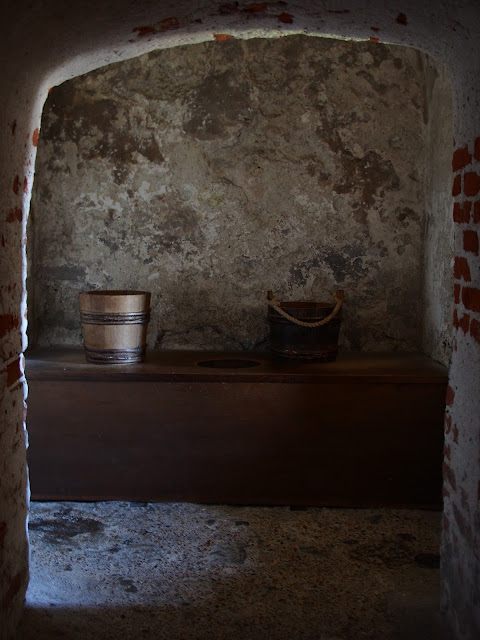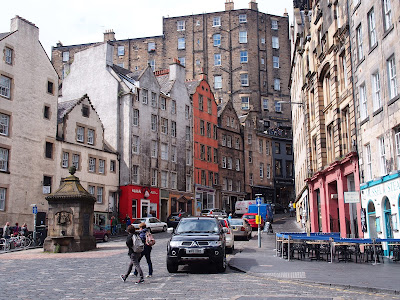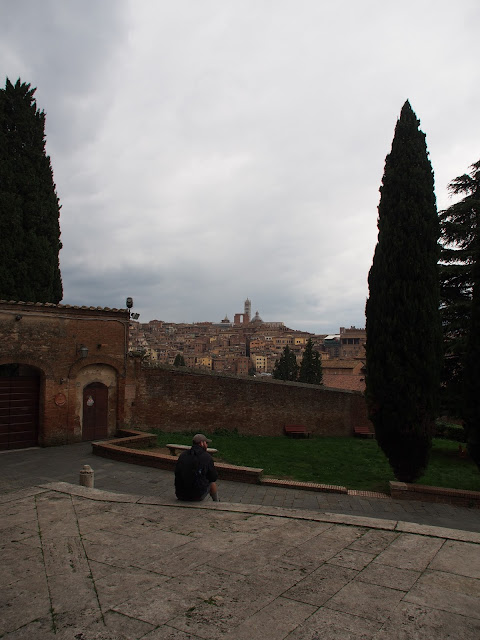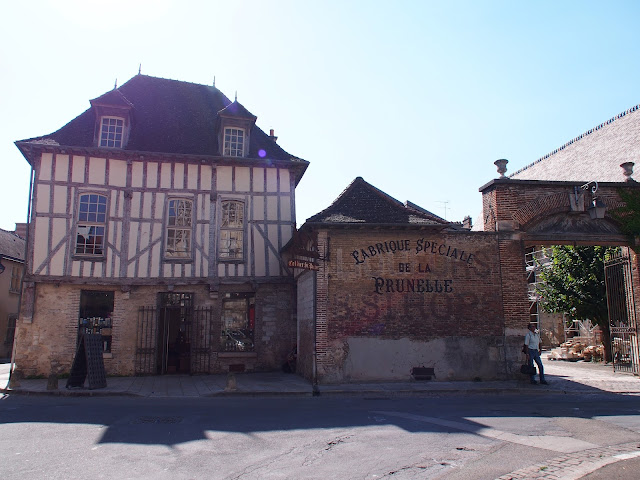Canterbury to Dover- The English Portion
7/18-19
36.1 km from Canterbury
On Monday morning I walked from my dorm room down into Canterbury and stopped at the cathedral to get my picture with the kilometer zero stone.
Then I set off. I started walking south and southeast for most of the first day. Unfortunately the two days I was in England it was during a heat wave, so I was stifling warm with my 40 lb backpack in the 85+ degree humidity.
For the short section through England, the Via Francigena follows the
North Downs Way to Dover, so most of the signs I saw didn't say
Via Francigena at all.
I only had two days in England on the Camino and stopped outside of Shepperdswell to camp my first night. The first two days were primarily walking through and on the edge of fields. I hardly saw anyone else and no other pilgrims! Quite often I would walk in the hedge in between two fields where the hedge would form an arch all the way around me. The shade was lovely, though it did block the wind and the bugs were tenacious!
I reached Dover on the coast around noon on Tuesday. I had booked a hostel for the night, so I dropped my bag and set off to climb up and see Dover Castle.
This castle has had a historical footprint in England since the Iron Age. It is likely the location of an Iron Age hill fort. After the Roman invasion in 43 AD, they built a lighthouse on the hilltop. Right next to the lighthouse the Saxons built the church of St Mary de Castro as well as a Saxon fort. Realizing the importance of holding Dover, William the Conqueror added a motte and bailey to the Saxon fort after his invasion in 1066. The present keep is from King Henry II of England's 12th-century additions. He built it primarily as a showpiece castle, so instead of building it up to the current standards of defense, he built it similar to the Normans' castles a century earlier. It evoked his right as king by showing his descent from his Norman ancestors. It was not as important for the castle to be defensively practical at that time as Henry II controlled half of what is currently France in his Angevin empire. After his sons lost much of England's French territories, Dover came to be on the front line of defense and there it has remained for the last 700 years.
During the Napoleonic era, a huge reconstruction and renovation project took place at the castle. Dover became a garrison town, and so they built miles and miles of tunnels in the chalk cliffs for barracks to house the troops. After the war, the tunnels were abandoned for over a century until WWII loomed over Europe. The tunnels were at first used as an air raid shelter then later as a command center and underground hospital. There are several levels in the tunnels, and only two are open to the public. In 1940, the tunnels were used as an evacuation for the French and British troops from Dunkirk France. This was called Operation Dynamo and was a wildly successful mission.
I visited the underground hospital tunnels first. They did a fantastic job of rekindling the wartime atmosphere. The lights were incredibly dim since they ran on batteries and only had generators for emergencies. They also had props and artifacts laying out so that you could see what the mess hall, the operation room, the bunk rooms, the toilets, and the kitchens would have looked like. They also played a recording that made the whole thing an immersive experience. You could hear the bombs and planes overhead, and the lights would dim further when they hit. You could listen to the nurses and officers talking and working. You could imagine how awful working in those dim conditions- with smoke added since they all smoked back then. You could imagine how difficult operating on wounded soldiers in the haze and smoke would have been. The whole thing was very well done and our guide was passionate and comical- always a plus! Unfortunately, due to the very realistic and dim conditions I was not able to take photographs...
Next, I visited the lighthouse and Saxon church. Unfortunately, the church was undergoing renovations, but the view was amazing.

Lastly, I explored the keep. They did an excellent job at recreating the bright colors and tapestries in the rooms. Since most of what is left over from medieval times has faded and the paint has worn off, we don't associate bright colors with them. At this time kings' courts were mobile, constantly moving from town to town throughout their domains. All the king's necessary belongings were carried with the court- furniture, livestock, food, women...
The kitchens were also recreated marvelously– props, sound effects and all.
I did walk up to the top of the keep where the views did not disappoint!!

After exploring the castle, I walked down to the beach and walked along the boardwalk while eating a raspberry Magnum ice cream bar. Ice cream was a requirement in that heat! I tried to walk over to the famous white cliffs of Dover, but several large roads and highways were in the way.
Luckily I got some good shots of the cliffs on the ferry ride over to Calais the next morning.
Tomorrow I leave for France!
36.1 km from Canterbury
On Monday morning I walked from my dorm room down into Canterbury and stopped at the cathedral to get my picture with the kilometer zero stone.
 |
| Looking fresh faced and naive at kilometer zero |
 |
| St Augustine's Abbey on the way out of Canterbury |
 |
| The first way-marker |
 |
| Small VF icon on the post between the signs |
 |
| Beautiful field of flowers |
 |
| Typical English portion of the route |
 |
| Not a soul in sight |
 |
| View of Dover Castle as I finished my walk to the town |
 |
| The castle watching over Dover |
 |
| Roman lighthouse (center) next to Saxon Church (left) |
 |
| 12th century Norman style keep (inside) and walls |
 |
| Ramparts looking over the marina |
During the Napoleonic era, a huge reconstruction and renovation project took place at the castle. Dover became a garrison town, and so they built miles and miles of tunnels in the chalk cliffs for barracks to house the troops. After the war, the tunnels were abandoned for over a century until WWII loomed over Europe. The tunnels were at first used as an air raid shelter then later as a command center and underground hospital. There are several levels in the tunnels, and only two are open to the public. In 1940, the tunnels were used as an evacuation for the French and British troops from Dunkirk France. This was called Operation Dynamo and was a wildly successful mission.
 |
| WWII additions to the defenses |
 |
| Additions in ramparts for artillery |
 |
| You can see the dark line of the French mainland from the castle |
 |
| Foundations for heavy artillery overlooking the town and marina |
Next, I visited the lighthouse and Saxon church. Unfortunately, the church was undergoing renovations, but the view was amazing.

 |
| Who spots the tiny Devon? |
 |
| The remains of a Saxon doorway in the church |
 |
| Beautiful tiling from 19th century |
 |
| A long-winded renovation history of the church- it was used to store coal! |
 |
| The banquet hall |
 |
| Children's room |
 |
| Throne room |
 |
| Beautiful gilt map |
 |
| Tapestry in throne room inspired by Bayeux tapestry |
 |
| King's bedchamber |
 |
| The latrines– necessary and mundane, yet always funny– why is that? |
 |
| Butcher's corner |
 |
| Perhaps making soup or wine? |

 |
| You can see the town of Dover below several layers of ramparts |
 |
| Needed to get a picture of me in here somewhere |
 |
| The official start and finish for the North Downs Way in Dover |
 |
| The beach was made of small rocks that hurt your feet, it was funny watching the bathers hobble to the water and back |
 | |
| Hot summer day in Dover = everyone on the beach |
Tomorrow I leave for France!
Until next time!







Dover Castle looks amazing! I would love to see this place in person someday. This blog is great so far! I can't wait to see where you go next, Devon!
ReplyDeleteIt was incredible! I really want to visit more castles in the UK!
ReplyDelete